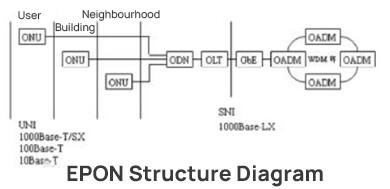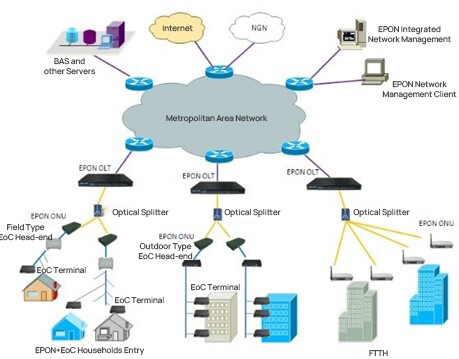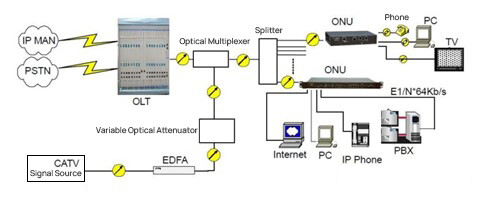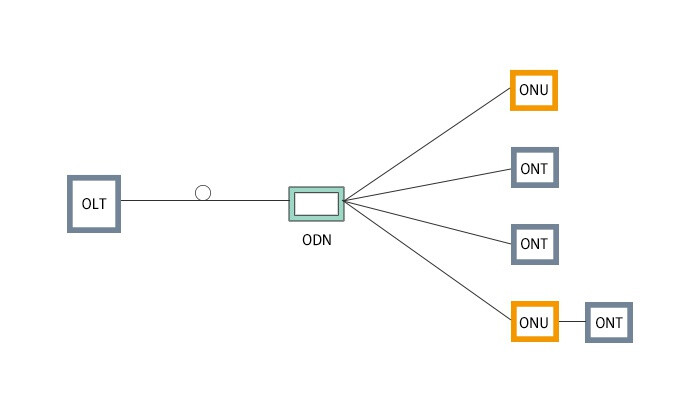Optical Access Network (OAN) refers to a type of access network that uses optical fibre as the transmission medium in whole or in part between the local exchange, or the remote module and the user. The current access network is mainly copper (e.g. twisted pair telephone lines), which has a high failure rate and high maintenance and operation costs. OAN was introduced firstly to reduce the maintenance and operation costs and failure rate of copper networks, secondly to support the development of new services, especially multimedia and broadband services, and finally to improve user access performance. Transmission services on copper cables are often subject to a variety of interference and distance restrictions, user access rates are generally not very high, the transmission distance is usually limited to 10km, while the fiber optic access network, technically superior to copper networks, subject to environmental interference and distance restrictions far from copper networks, and fiber optic transmission rates than the traditional copper transmission rates, with very obvious development potential. The use of fiber optic access network has become the main way to solve the development of telecommunications calm, fiber optic access network is not only suitable for new user cells, but also the need to update the existing copper cable network is the main alternative means.
The optical access network network can be divided into passive optical network (PON) and active optical network (AON) according to whether the access network outdoor transmission facilities contain source equipment.
Active optical networks (AON)
Current active optical access networks mainly refer to integrated digital loop carrier systems (IDLC). Active optical networks use electrical multiplexer splitting to extend transmission distances and are characterised by simple technology, easy implementation and strong networking capabilities. [2]
Due to the low price of IDLC technology and first transmission characteristics make it the mainstream of narrowband access network technology, DLC is not a new technology, but combined with the open interface V 5.1/V 5.2 and transmitted on the fiber integrated DLC (IDLC), it shows a strong vitality, the current 130 million subscriber lines in the United States, DLC/IDLC has occupied 36 million lines, of which IDLC accounts for 27 million lines.
Passive Optical Network (PON)
Passive minimises the cost of fibre loops and offers higher benefits and growth potential as fibre has great capacity and can provide users with a proven 155M bit/s download data stream.
Passive optical access networks use optical splitters for splitting, easy expansion and roll-out of services, and low maintenance costs.
EPON
A new technology, EPON (Ethernet PON, known as GPON by the ITU), has emerged from the idea of combining passive optical networks at the physical layer with the most promising layer 2 Ethernet of the future. A new combination that can provide greater bandwidth, lower cost and wider service capability. The architecture block diagram is shown in Figure 1.

EPON technology combines the unique network structure advantages of passive optical networks with the traditional low cost advantages of Ethernet, making it more competitive in the access field. This bandwidth capacity can fully meet the user access demand in the next decades.
APON Technology
APON technology combines the advantages of ATM and PON with transmission rates of up to 622M bps/155M bps, providing a cost-effective platform for multimedia service delivery and efficient use of network resources, representing an important strategic direction for the development of access networks in the multimedia era.
Its advantages include: the combination of ATM multi-service multi-bit rate support capability and PN transparent broadband transmission capability, with very flexible access to services; the range of services provided from image distribution services with interactivity to data transmission, LAN interconnection, transparent virtual channels, etc.; and better cost performance.
WDMPON
Wavelength Division Multiplexing (WDM) is an effective technical means of exploiting fibre optic bandwidth resources for both optical transport networks and optical access networks.WDM has been widely used in optical transport networks and the application of WDM in access networks has also attracted interest, with the ITU-T having completed the development of a standard for broadband access networks using WDM (Recommendation No. G.983.3).
Broadband optical access networks using WDM have a strong service transmission capability, and in addition to being able to transmit ATM signals, they can also transmit image distribution services and additional digital signals using enhanced bands, and can provide users with all the new services currently known and under discussion.
Passive optical access networks (PON) generally have three components: optical line terminal OLT, optical network unit ONU, optical distribution network ODN, where the OLT and ONU optical access network core components.

OLT is Optical Line Terminal, which is a telecommunication equipment used to connect the fiber optic trunk line, and is equivalent to a switch or router in a traditional communication network. Placed at the local end, the most important functions performed are traffic scheduling, buffer control, and the provision of user-oriented passive fibre-optic network interfaces and bandwidth allocation. Simply put, it performs two functions: upstream, it provides upstream access to the PON network; downstream, it sends the acquired data through the ODN network and distributes it to all ONU user terminals.

The ONU is the Optical Network Unit, which has two roles: to selectively receive broadcasts sent by the OLT, and to respond to the OLT if the data needs to be received; and to collect and cache the Ethernet data that the user needs to send, and send the cached data to the OLT according to the allocated sending window.
Different deployments of ONUs in the FTTx network have different access methods, for example FTTC (Fiber To The Curb): ONUs are placed in the central server room of the cell; FTTB (Fiber To The Building): ONUs are placed in the junction box of the building; FTTH (Fiber To The Home): ONUs are placed in the in the home user.
Below is a photo of an EPON ONU product

The ONT is the Optical Network Terminal, which is the end unit of FTTH, commonly known as the "optical cat", similar to the xDSL cat, while the ONU is the Optical Network Unit, which may have other networks between it and the end user. The ONT is a component of the ONU. Below is a GPON ONT product diagram.

GPON ONT product diagram
The OLT is the management side and the ONU is the terminal; the service turn-up of the ONU is all sent down through the OLT, and the two are master-slave relationship. Multiple ONUs can be connected under one OLT through splitters.

ODN is Optical Distribution Network, ODN is FTTH optical cable network based on PON equipment. It is the physical channel for optical transmission between OLT and ONU, and its main function is to complete the bi-directional transmission of optical signals, usually consisting of optical fibre cables, optical connectors, optical splitters and supporting equipment for installing and connecting these devices, of which the most important component is the splitter.
Functionally, ODN can be divided into four parts: feeder cable subsystem, distribution cable subsystem, access cable subsystem and fibre terminal subsystem from the bureau end to the user end.

In FTTx development, the access layer requires a huge new fibre distribution network, i.e. ODN network.
Ascent Optics can provide the following products for optical access network applications